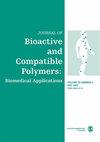Development and characterization of skin substitutes from electrospun polycaprolactone/silk fibroin
IF 2.1
4区 生物学
Q3 BIOTECHNOLOGY & APPLIED MICROBIOLOGY
引用次数: 0
Abstract
Tissue-engineered skin substitutes have great potential to treat chronic wounds and high-degree burns. Existing solutions, such as Integra Dermal Template, are extensively used for skin defects. However, these templates are still lacking in terms of recreating the functionality of the native tissue and providing scarless healing. In this study, polycaprolactone/silk fibroin (PCL/SF)-based nanofibers with varying blends were fabricated and characterized to develop a novel skin substitute. Morphological analysis showed that the nanofiber distribution of each sample was homogenous without showing any beads. In terms of mechanical properties, all the samples other than SF showed sufficient mechanical strength. It was observed that adding a specific amount of SF into the PCL nanofiber improves the tensile strength of the samples due to the introduction of intermolecular interactions from the functional groups of SF. In addition, incorporating SF into PCL improved Young’s modulus of the PCL nanofibers since SF provides stiffness and structural integrity to the overall structure. Water contact angle analysis was performed as the hydrophilicity of a biomaterial is a significant factor in cell functionality. Each sample had a contact angle between 33° and 48°, indicating the adequate hydrophilicity of nanofibers for advanced cell proliferation other than PCL. Cell proliferation and viability studies were conducted with the seeding of primary human keratinocytes on the samples. It was examined that scaffolds containing blends of PCL and SF resulted in higher cell proliferation and viability after 7 days compared to pure PCL and SF nanofibers.电纺聚己内酰胺/蚕丝纤维素皮肤替代品的开发和特性分析
组织工程皮肤替代品在治疗慢性伤口和高度烧伤方面具有巨大的潜力。现有的解决方案,如Integra真皮模板,广泛用于皮肤缺陷。然而,这些模板在重建原生组织的功能和提供无疤痕愈合方面仍然缺乏。本研究制备了不同共混物的聚己内酯/丝素(PCL/SF)纳米纤维,并对其进行了表征,以开发一种新型的皮肤替代品。形态学分析表明,各样品的纳米纤维分布均匀,无微珠。力学性能方面,除SF外,其余样品均表现出足够的机械强度。研究发现,在PCL纳米纤维中加入一定量的SF,由于SF的官能团引入了分子间相互作用,从而提高了样品的抗拉强度。此外,将SF加入PCL中可以提高PCL纳米纤维的杨氏模量,因为SF提供了整体结构的刚度和结构完整性。由于生物材料的亲水性是细胞功能的重要因素,因此进行了水接触角分析。每个样品的接触角在33°到48°之间,表明纳米纤维具有足够的亲水性,可用于除PCL外的晚期细胞增殖。用原代人角质形成细胞在样品上进行细胞增殖和活力研究。结果表明,与单纯的PCL和SF纳米纤维相比,含有PCL和SF纳米纤维的支架在7天后具有更高的细胞增殖和活力。
本文章由计算机程序翻译,如有差异,请以英文原文为准。
求助全文
约1分钟内获得全文
求助全文
来源期刊

Journal of Bioactive and Compatible Polymers
工程技术-材料科学:生物材料
CiteScore
3.50
自引率
0.00%
发文量
27
审稿时长
2 months
期刊介绍:
The use and importance of biomedical polymers, especially in pharmacology, is growing rapidly. The Journal of Bioactive and Compatible Polymers is a fully peer-reviewed scholarly journal that provides biomedical polymer scientists and researchers with new information on important advances in this field. Examples of specific areas of interest to the journal include: polymeric drugs and drug design; polymeric functionalization and structures related to biological activity or compatibility; natural polymer modification to achieve specific biological activity or compatibility; enzyme modelling by polymers; membranes for biological use; liposome stabilization and cell modeling. This journal is a member of the Committee on Publication Ethics (COPE).
 求助内容:
求助内容: 应助结果提醒方式:
应助结果提醒方式:


